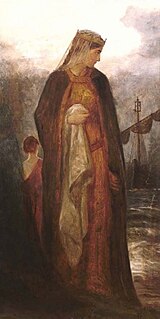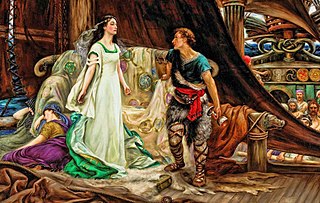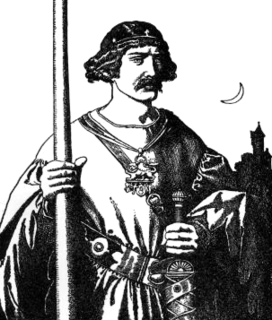Related Research Articles

Marie de France was a poet, possibly born in what is now France, who lived in England during the late 12th century. She lived and wrote at an unknown court, but she and her work were almost certainly known at the royal court of King Henry II of England. Virtually nothing is known of her life; both her given name and its geographical specification come from her manuscripts. However, one written description of her work and popularity from her own era still exists. She is considered by scholars to be the first woman known to write francophone verse.

Guinevere, also often written in Modern English as Guenevere or Guenever, was, according to Arthurian legend, an early-medieval queen of Great Britain and wife of King Arthur. First recorded in literature by the early 12th century, nearly 700 years after the purported times of Arthur, Guinevere has been portrayed as everything from a villainous and opportunistic traitor to a fatally flawed but noble and virtuous lady. A notably recurring aspect of many records of the legend are the also variably told stories of her abduction.

Lancelot du Lac, also written as Launcelot and other variants, is a character in some versions of Arthurian legend, where he is typically depicted as King Arthur's close companion and one of the greatest Knights of the Round Table. In the French-inspired Arthurian chivalric romance tradition, Lancelot is the orphaned son of King Ban of the lost kingdom of Benwick, raised in the fairy realm by the Lady of the Lake. A hero of many battles, quests and tournaments, and famed as a nearly unrivalled swordsman and jouster, Lancelot becomes the lord of the castle Joyous Gard and personal champion of Arthur's wife Queen Guinevere. But when his adulterous affair with Guinevere is discovered, it causes a civil war that is exploited by Mordred to end Arthur's kingdom.
The lais of Marie de France are a series of twelve short narrative Breton lais by the poet Marie de France. They are written in Anglo-Norman and were probably composed in the late 12th century. The short, narrative poems generally focus on glorifying the concept of courtly love by the adventures of their main characters. Marie's lais are thought to form the basis for what would eventually become the genre known as the Breton lais. Despite her stature in Anglo-Norman literature and medieval French literature generally, little is known of Marie herself, but it is thought that she was born in France and wrote in England.
Sir Launfal is a 1045-line Middle English romance or Breton lay written by Thomas Chestre dating from the late 14th century. It is based primarily on the 538-line Middle English poem Sir Landevale, which in turn was based on Marie de France's lai Lanval, written in a form of French understood in the courts of both England and France in the 12th century. Sir Launfal retains the basic story told by Marie and retold in Sir Landevale, augmented with material from an Old French lai Graelent and a lost romance that possibly featured a giant named Sir Valentyne. This is in line with Thomas Chestre's eclectic way of creating his poetry.

Tristan and Iseult is a chivalric romance retold in numerous variations since the 12th century, with a lasting impact on Western culture. The story is a tragedy about the illicit love between the Cornish knight Tristan (Tristram) and the Irish princess Iseult. It tells of Tristan's mission to escort Iseult from Ireland to marry his uncle, King Mark of Cornwall. On the journey home, the two of them ingest a love potion which brings about the adulterous relationship.

Sir Ywain, also known as Yvain, Owain, Uwain(e), Ewaine, Iwain, Iwein, Ivain, Ivan, etc., is a Knight of the Round Table in Arthurian legend, wherein he is often the son of King Urien of Gorre and the sorceress Morgan le Fay. The historical Owain mab Urien, on whom the literary character is based, was the king of Rheged in Great Britain during the late 6th century.

Lancelot, the Knight of the Cart, is a 12th-century Old French poem by Chrétien de Troyes, although it is believed that Chrétien did not complete the text himself. It is one of the first stories of the Arthurian legend to feature Lancelot as a prominent character. The narrative tells about the abduction of Queen Guinevere, and is the first text to feature the love affair between Lancelot and Guinevere.

"Bisclavret" is one of the twelve Lais of Marie de France written in the 12th century. Originally written in French, it tells the story of a werewolf who is trapped in lupine form by the treachery of his wife. The tale shares a common ancestry with the comparable Lay of Melion, and is probably referenced in Sir Thomas Malory's Le Morte d'Arthur with the tale of Sir Marrok, who has a similar story.
Lanval is one of The Lais of Marie de France. Written in Anglo-Norman, it tells the story of Lanval, a knight at King Arthur's court, who is overlooked by the king, wooed by a fairy lady, given all manner of gifts by her, and subsequently refuses the advances of Queen Guinevere. The plot is complicated by Lanval's promise not to reveal the identity of his mistress, which he breaks when Guinevere accuses him of having "no desire for women". Before Arthur, Guinevere accuses Lanval of shaming her, and Arthur, in an extended judicial scene, demands that he reveal his mistress. Despite the broken promise, the fairy lover eventually appears to justify Lanval, and to take him with her to Avalon. The tale was popular, and was adapted into English as Sir Landevale, Sir Launfal, and Sir Lambewell.
"Guigemar" is a Breton lai, a type of narrative poem, written by Marie de France during the 12th century. The poem belongs to the collection known as The Lais of Marie de France. Like the other lais in the collection, Guigemar is written in the Anglo-Norman language, a dialect of Old French, in rhyming octosyllabic couplets.
"Equitan" is a Breton lai, a type of narrative poem, written by Marie de France sometime in the 12th century. The poem belongs to what is collectively known as The Lais of Marie de France. Like the other lais in the collection, Equitan is written in the Anglo-Norman language, a dialect of Old French, in rhyming octosyllabic couplets. In this 320 line poem, the author cautions that those who plot to harm another person may find only their own misfortune.
"Laüstic", also known as "Le Rossignol", "Le Laustic", "Laostic", and "Aüstic", is a Breton lai by the medieval poet Marie de France. The title comes from the Breton word for "nightingale" (eostig), a symbolic figure in the poem. It is the eighth poem in the collection known as the Lais of Marie de France, and the poem is only found in the manuscript known as Harley 978. Like the other poems in the collection, Laüstic is written in the Anglo-Norman dialect of Old French, in couplets eight syllables long.
"Chevrefoil" is a Breton lai by the medieval poet Marie de France. The eleventh poem in the collection called The Lais of Marie de France, its subject is an episode from the romance of Tristan and Iseult. The title means "honeysuckle," a symbol of love in the poem. "Chevrefoil" consists of 118 lines and survives in two manuscripts, Harley 978 or MS H, which contains all the Lais, and in Bibliothèque Nationale, nouv. acq. fr. 1104, or MS S.
"Chaitivel", also known as "Les Quatre Deuils" or "Le Malheureux" in modern French or "The Four Sorrows" in English, is a Breton lai by the medieval poet Marie de France. Chaitivel is the tenth poem in the collection known as the Lais of Marie de France and is one of very few lais to contain alternate titles. Like the other poems in this collection, Chaitivel is written in the Anglo-Norman dialect of Old French, in couplets of eight syllables in length.
Tyolet is an anonymous Breton lai that takes place in the realm of King Arthur. It tells the tale of a naïve young knight who wins the hand of a maiden after a magical adventure.
Melion is an anonymous Breton lai that tells the story of a knight who transforms into a werewolf for the love of his wife who betrays him.
Strengleikar is a collection of twenty-one Old Norse prose tales based on the Old French Lais of Marie de France. It is one of the literary works commissioned by King Haakon IV of Norway for the Norwegian court, and is counted among the Old Norse Chivalric sagas. The collection is anonymous. It has been attributed to Brother Robert, a cleric who adapted several French works into Norse under Haakon, the best known of which is Tristrams saga ok Ísöndar, but there is also reason to think that the collection may be a gathering of the work of several different translators. Unlike many medieval translations, the Strengleikar are generally extremely close in sense to the Old French originals; the text which differs most is Milun, which is abridged to half its original length.
Sir Degaré is a Middle English romance of around 1,100 verse lines, probably composed early in the fourteenth century. The poem is often categorised as a Breton lai because it is partly set in Brittany, involves an imagined Breton royal family, and contains supernatural elements similar to those found in some other examples, such as Sir Orfeo. Sir Degaré itself does not explicitly claim to be a Breton lai. The poem is anonymous, and no extant source has ever firmly been identified.
Guiomar is the best known name of a character appearing in many medieval texts relating to the Arthurian legend, often in relationship with Morgan le Fay or a similar fairy queen type character.
References
- Bruce, Christopher W. (1998). The Arthurian Name Dictionary. Routledge. ISBN 0-8153-2865-6.
- Marie de France; Busby, Keith (translator) (2003). The Lais of Marie de France. New York: Penguin ISBN 0-14-044759-8.